Related Research Articles

Johann Wilhelm Meigen was a German entomologist famous for his pioneering work on Diptera.

The Anthomyiidae are a large and diverse family of Muscoidea flies. Most look rather like small houseflies, but are commonly drab grey. The genus Anthomyia, in contrast, is generally conspicuously patterned in black-and-white or black-and-silvery-grey. Most are difficult to identify, apart from a few groups such as the kelp flies that are conspicuous on beaches.
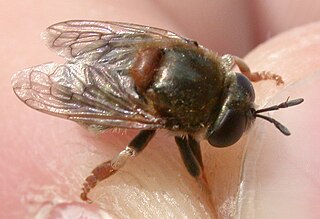
The subfamily Microdontinae contains slightly more than 400 species of hoverflies and, while diverse, these species share several characteristics by which they differ from other syrphids. The Microdontinae are myrmecophiles, meaning they live in the nests of ants. Larval Microdontinae are scavengers or predators in ant nests, and, in contrast to other syrphid larvae, have no readily apparent body segmentation. Some species also do not exhibit the typical adult flower-visiting behaviour of other hoverflies, but instead remain near their larval host colonies.

The Chamaemyiidae are a small family of acalyptrate flies with less than 200 species described worldwide. The larvae of these small flies are active and predatory and are often used for biological control of aphids, scale insects, and similar pests. Chamaemyiid fossils are poorly represented in amber deposits, but a few examples are known from the Eocene epoch onwards.
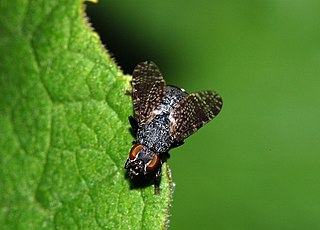
The Platystomatidae are a distinctive family of flies (Diptera) in the superfamily Tephritoidea.

Hybotidae, the typical dance flies, are a family of true flies. They belong to the superfamily Empidoidea and were formerly included in the Empididae as a subfamily.
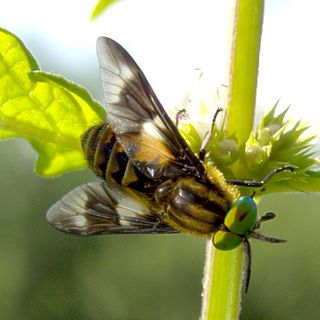
Superfamily Tabanoidea are insects in the order Diptera.
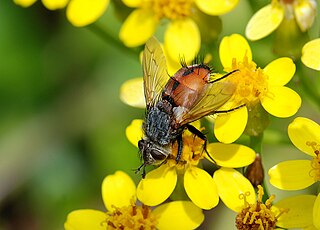
Tachina is a genus of large flies in the family Tachinidae. There are approximately 600 species worldwide. Most have larvae that are parasitoids of Lepidopteran caterpillars.
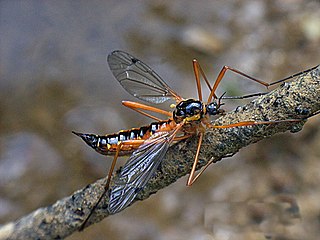
Ctenophora is a genus of true crane flies. The species are large, shiny black craneflies with large yellow, orange, or red markings to mimic wasps. Males have comb-like antennae. The larvae are saproxylic. The species are confined to old deciduous forests, orchards, and other habitats with continuity of the presence of dying and fallen trees. Ctenophora species are important bioindicators.

Chironomini is a tribe of midges in the non-biting midge family (Chironomidae).

Rhaphium is a genus of flies in the family Dolichopodidae. It is the largest genus within the subfamily Rhaphiinae, with over 200 species currently known.

Herina is a genus of flies in the family Ulidiidae. It is possibly the largest genus in the family.

Empis is a genus of dance fly, in the fly family Empididae. It contains the following subgenera and species:
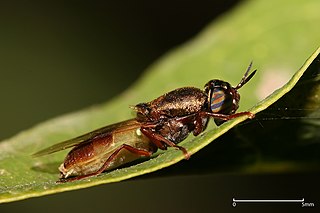
Odontomyia is a genus of soldier flies in the family Stratiomyidae. There are at least 220 described species in Odontomyia.

The Brachyopini is a tribe of hoverflies. Unlike many members of this family these flies are generally darker and less colourful though some genera contain species with an attractive metallic lustre e.g. Chrysogaster. Some like Brachyopa are associated with sap runs where their larvae feed on decaying sap. Others are found in boggy areas where their often semiaquatic larvae feed on decaying organic matter.

Laphria is a genus described by Johann Wilhelm Meigen in 1803, belonging to the family Asilidae, subfamily Laphriinae. Members of this genus are known as bee-like robber flies. This genus has a Holarctic distribution, occurring in Europe, Asia, and North America. They prey on a variety of insects, including other robber flies, bees, wasps and beetles. Like other asilids, they use their proboscis to penetrate the body of their prey and inject enzymes which dissolve the tissues.

Chamaemyia is a genus of flies in the family Chamaemyiidae. It is the type genus of its family.
Ceratopogon is a genus of flies belonging to the family Ceratopogonidae.
Heptatoma is a genus of flies belonging to the family Tabanidae.
References
- 1 2 3 "Calobata Meigen, 1803". www.gbif.org. Retrieved 19 February 2021.